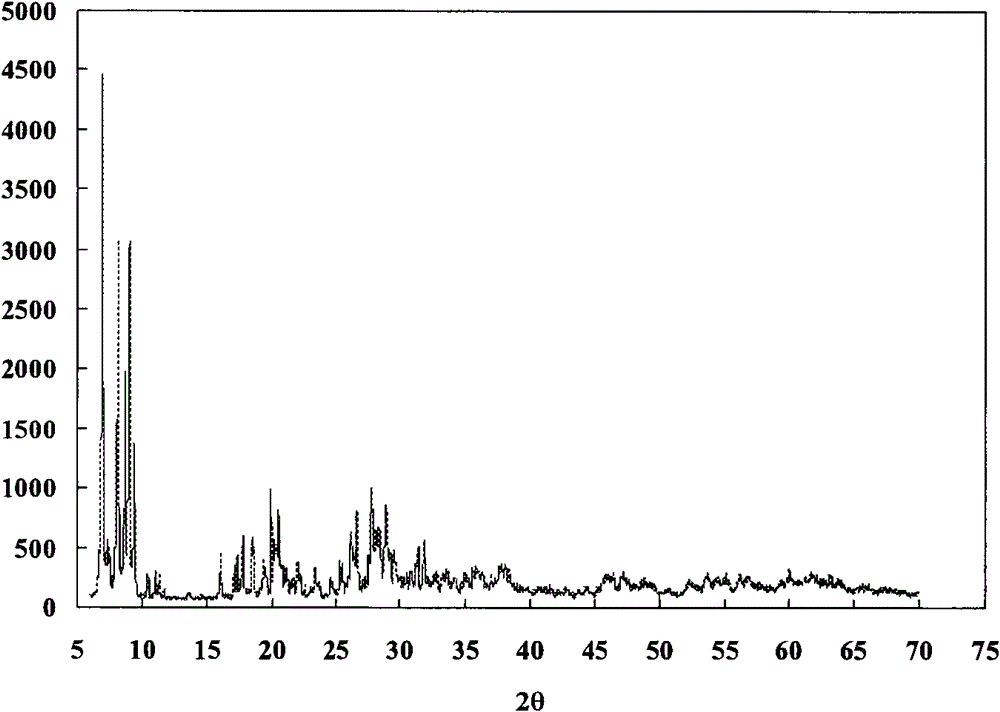Preparation method of phosphotungstic heteropoly acid
A technology of phosphotungstic heteropoly acid and phosphotungstic acid, which is applied in chemical instruments and methods, physical/chemical process catalysts, chemical/physical processes, etc., can solve problems such as poor production safety, and achieve improved production and operation safety. The effect of technical effects
- Summary
- Abstract
- Description
- Claims
- Application Information
AI Technical Summary
Problems solved by technology
Method used
Image
Examples
Embodiment 1
[0017] Dissolve sodium tungstate with a concentration of 0.01 g / ml and disodium hydrogen phosphate with a concentration of 0.05 g / ml in 200 ml of hot water. While heating and stirring, add concentrated hydrochloric acid to the solution. After the solution is clarified, add 20 mol / L C 16 h 33 N + Cl - in chloroform solution, C 16 h 33 N + Cl - The addition amount is 0.05 mol / g sodium tungstate, while stirring vigorously, obtain phosphotungstic heteropolyacid catalyst. Centrifuge to separate the catalyst, wash the catalyst with deionized water until the pH of the washing solution is 5, and then dry it under nitrogen flow for 3 hours at a drying temperature of 180°C; then roast it under nitrogen flow at a temperature of 500°C for 3 hours to produce phosphorus Tungsten heteropoly acid 8.5 g H 3 PW 12 o 40 ·xH 2 O(x=0~30) catalyst.
[0018] The XRD spectrum of the sample phosphotungstic acid is shown in figure 1 . From figure 1 It can be seen that the 2θ of the chara...
Embodiment 2
[0020] Dissolve sodium tungstate with a concentration of 0.05 g / ml and disodium hydrogen phosphate with a concentration range of 0.1 g / ml in 200 ml of hot water, add concentrated hydrochloric acid to the solution while heating and stirring, and after the solution is clarified, add concentration 20 mol / L C 18 h 37 N + Cl - solution in dichloromethane, C 18 h 37 N + Cl - The addition amount of the sodium tungstate is 0.1 mol / g, while vigorously stirring to obtain a phosphotungstic heteropolyacid catalyst. Centrifuge to separate the catalyst, wash the catalyst with deionized water until the pH of the washing solution is 5, and then dry it under nitrogen flow for 10 hours at a drying temperature of 120°C; then roast it under nitrogen flow at a temperature of 300°C for 8 hours to produce phosphorus Tungsten heteropoly acid 44 g H 3 PW 12 o 40 ·xH 2 O(x=0~30) catalyst.
[0021] The XRD spectrum of sample phosphotungstic acid and figure 1 Similarly, there are characteris...
Embodiment 3
[0023] Dissolve sodium tungstate with a concentration of 0.1 g / ml and disodium hydrogen phosphate with a concentration of 0.15 g / ml in 200 ml of hot water, add concentrated hydrochloric acid to the solution while heating and stirring, and after the solution is clarified, add a concentration of 20 mol / L C 22 h 45 N + Cl - ethanol solution, C 22 h 45 N + Cl - The addition amount of the sodium tungstate is 0.2 mol / g, while vigorously stirring to obtain a phosphotungstic heteropolyacid catalyst. Centrifuge to separate the catalyst, wash the catalyst with deionized water until the pH of the washing solution is 5, and then dry it under nitrogen flow for 15 hours at a drying temperature of 80°C; then roast it under nitrogen flow at a temperature of 350°C for 6 hours to produce phosphorus Tungsten heteropoly acid 88g H 3 PW 12 o 40 ·xH 2 O(x=0~30) catalyst.
[0024] The XRD spectrum of sample phosphotungstic acid and figure 1 Similarly, there are characteristic diffractio...
PUM
 Login to View More
Login to View More Abstract
Description
Claims
Application Information
 Login to View More
Login to View More - R&D
- Intellectual Property
- Life Sciences
- Materials
- Tech Scout
- Unparalleled Data Quality
- Higher Quality Content
- 60% Fewer Hallucinations
Browse by: Latest US Patents, China's latest patents, Technical Efficacy Thesaurus, Application Domain, Technology Topic, Popular Technical Reports.
© 2025 PatSnap. All rights reserved.Legal|Privacy policy|Modern Slavery Act Transparency Statement|Sitemap|About US| Contact US: help@patsnap.com

